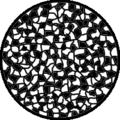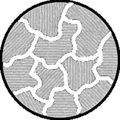Structure (material science)
The term structure or the microstructure can be defined independently of the material (metal, ceramic or polymer) according to Schatt / Worch as follows: "The term structure characterizes the nature of the totality of those partial volumes, each of which in terms of its composition and the spatial arrangement of its building blocks in With reference to a fixed axis cross placed in the material, it is homogeneous in a first approximation. [...]. The structure is characterized by the type, shape, size, distribution and orientation of the structural components. "
The structural components ( crystallites or grains, fillers and amorphous areas) are usually microscopic and can be described qualitatively and quantitatively , for example using a light microscope . The corresponding specialist areas are for metallic materials: metallography , for ceramic materials: ceramography and for polymers: plastography .
In the field of metallic materials and alloys , a distinction is made between the primary structure and the secondary structure, even if the term structure is usually used colloquially to refer to the secondary structure.
Single crystals and amorphous materials do not have a structure that can be resolved by light microscopy.
Primary structure
The primary structure is created when the melt of a crystalline substance cools down. When the solidification temperature is reached, crystals form in many places within the melt, starting from randomly formed crystallization nuclei. These crystals grow in the further course of cooling until they finally collide. Depending on whether the melt is a single-phase or multiphase solidifying substance, segregation phenomena can still occur in the course of the crystallization of the melt on the dendrites . This segregation is due to the different melting points of the two substances and their solubilities. The individual crystals, depending on the chance of their formation and their position in the melt, have different orientations and cannot grow together at the interfaces.
If the primary structure is made visible using the metallographic process , a qualitative impression of the inhomogeneities of the material is obtained. In the case of cast materials, this usually also shows the dendrite structures.
Secondary structure
In many cases, after the melt has solidified, there is a quasi "involuntary" heat treatment due to the residual heat. This process is called self- starting . Self-tempering, as well as technical heat treatment , leads to transformation , precipitation and recrystallization processes , which result in the secondary structure. However, these are always solid-state reactions.
Attempt to form a structure
A structure that is visible to the naked eye can be created with the help of a simple experiment:
"Plumber's solder" (lead-tin alloy with about 35% tin) is heated and melted in a steel trowel with a spirit or Bunsen burner. The addition of rosin makes the surface oxide-free (the resulting slag is pushed aside). If the melt is now allowed to cool slowly, the crystallization and structure formation can be observed directly.
Micrographs and their use

The structure of metals is worked out with the means of metallography on material samples and the micrographs visible under the light microscope are then analyzed. By assessing the size, shape and arrangement of the crystallites with their grain boundaries, as well as impurities, extensive statements can be made about the heat treatment condition and the expected mechanical properties.
Conversely, the structure of the metals (and the resulting technological properties) can be set very precisely through targeted heat treatment. So z. B. in austenitic CrNi steels a certain grain size is set in order to achieve a defined elongation and strength .
To provide evidence, especially when analyzing damage cases, the structures are usually documented photographically.
Selection of schematic micrographs
This is a selection of schematically shown micrographs:
General
Pure substance , alloy with solid solution formation
Steels
Perlite-secondary cementite
Sources / literature
- ↑ W. Schatt, H. Worch (Ed.): Material Science. Stuttgart: German publishing house for basic industry, 1996. ISBN 3-342-00675-7 .







